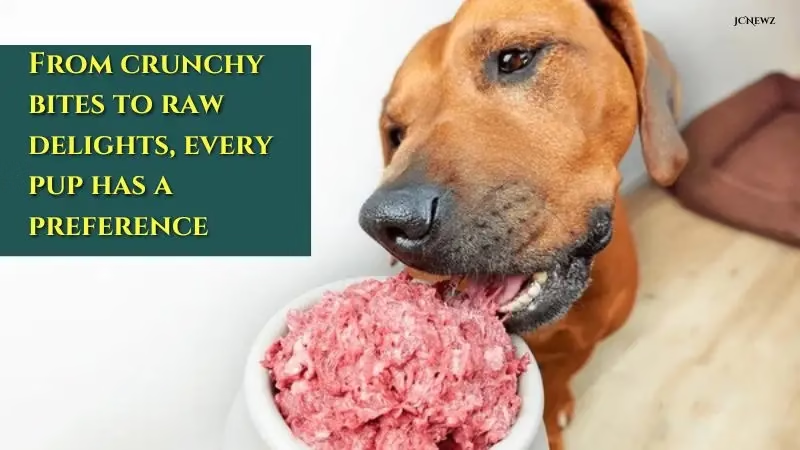Table of Contents
The feeding of dogs is a major decision that any responsible dog parent is faced with. Today there are many contrasting opinions, making choosing one over another an infuriating matter. Two options gain attention when it comes to feeding methods: raw and kibble.
Different from many years ago when kibble was the industry standard for many years in the end, raw diets are trending among dog parents seeking health and nutrition alternatives. Or so the story goes; are either truly better than the other? Here is the good, the bad, and the ugly so that you can decide which one is better for your dog.
Understanding the Basics
What Is a Raw Food Diet?
In the dog world, the term raw food diet can be abbreviated BARF that either stands for Biologically Appropriate Raw Food or Bones and Raw Food, formed depending on what nutrients wild wolves would procure in the wild.
Typical raw food for dogs consists of:
- Raw muscle meat (often still on the bone)
- Organ meats (liver, kidneys, heart)
- Raw meaty bones
- Eggs
- Dog-safe fruits and vegetables
- Yogurt or kefir
- Supplements (omega oils, vitamins, etc.)
This diet can be homemade or purchased as commercially prepared frozen or freeze-dried raw food.
What Is Kibble?
Kibble is a dry dog food preparation. The ingredients, such as meat meals, grains, veggies, and additives, are ground into a dough, subjected to high heat, formed into tiny pellets, and finally dried for packaging.
Being convenient, cheap, and with a long shelf-life, kibble is mostly given to dogs and comes in different formulations pertaining to breed, life-stage, and health consideration.
The Pros and Cons
Raw Diet: The Pros

1. Shinier Hair and Healthier Skin
Perhaps because of the higher fat content and natural oils in raw meat—and also with a lack of artificial preservatives and fillers—raw-fed dogs seem to carry shinier coats and better skin.
2. Better Dental Health
Raw meaty bones chew away the buildup of plaque and tartar. In this way, they act as a toothbrush. Consequently, dogs that are fed raw tend to have better breath and cleaner teeth.
3. More Energy and Vitality
After the change to raw food, many owners have observed more-than-usual energy levels. Higher nutrient bioavailability may be responsible for this, thus raw diets could perhaps increase a dog’s level of energy and alertness.
4. Smaller and Firmer Stools
Raw-fed dogs tend to have smaller, more firm stools because of the improved digestion and less filler waste. This can be a plus for gastrointestinal health.
5. Less Allergies and Sensitivities
Dogs that are food allergic or intolerant generally experience relief when common allergens in kibble (such as grains, artificial dyes, or preservatives) are removed.
Raw Diet: The Cons
1. Nutritional Imbalances
Catered to by nobody, homemade raw food diets are easily deficient in calcium and phosphorus and are also deficient in vitamins A and D. And these can cause some pretty serious health problems in the longer run.
2. Bacteria Hazards
Raw meat can harbor harmful pathogens such as Salmonella and E. coli, which threaten the health of dogs and humans alike, especially children and immunocompromised adults.
3. Time-Consuming and Expensive
Raw diet planning, purchasing, and preparation are demanding in terms of time and effort. Commercial raw products are typically pricier than kibble.
4. Not For All Dogs
Dogs with weaker immune systems, some medical conditions, or specific needs may not prosper on raw diets. Raw diets give special consideration to puppy and senior dog formulations.
Kibble: The Pros

1. Convenience
Such kibble is extremely easy to store, measure, and serve. It is, thus, the best alternative for the busy pet parent or one having multiple dogs.
2. Nutritionally Balanced
Most reputable kibble-track manufacturers follow the AAFCO guidelines, meaning that this food should provide complete and balanced nutrition for canine maintenance for the dog’s entire life.
3. Cost-Efficient
Kibble is usually more favorable in terms of price, especially for bigger dogs and multiple-dog households. Bulk buying and good shelf life add to its value proposition.
4. Support by Veterinarians
Veterinarians are more aware of and familiar with kibble diets and may recommend specific products for dogs with health issues such as kidney diseases, obesity, and diabetes.
5. Special Formulations
Kibble has specialized formulations for the life stages (puppy, adult, senior), size of breed, and medical conditions (such as weight control, hypoallergenic, and urinary health).
Kibble: The Cons
1. Highly Processed
Heat is used for processing the kibble, which tends to eradicate certain naturally occurring nutrients. Therefore, synthetic vitamins and minerals need to be mixed back in, although it is argued that the dog may not absorb them as well.
2. Questionable Ingredients
These are filled with cheap stuff in low-quality kibble: corn, wheat, soy, artificial preservatives, meat by-products. Such ingredients can trigger allergic reactions and cause health problems.
3. Inability to Protect Dental Health
Contrary to what they are marketed to do, most kibble does not clean teeth effectively, requiring many dogs to have dental chews and professional cleanings.
4. Possibility of Overeating
Free-feeding kibble encourages overeating and eventually obesity, especially in very inactive dogs.
Hybrid Approach: The Best of Both Worlds?

Some dog owners have turned to rotational feeding or hybrid diets, trying to mix the benefits of raw and kibble. A few examples of such may include:
- Feeding raw meals in the morning and kibble at night
- Using freeze-dried raw as a topper for dry food
- Adjusting between raw and kibble weekly or monthly
This method is fairly flexible, together with nutritional variety and convenience of kibble, still giving a bit of the freshness and advantages of raw feeding. Adjusting correctly through this change helps maintain the health of the digestive systems of your dog. Consult your vet before attempting a hybrid route.
What Do The Vets and Experts Say?
Veterinary opinions on the raw-vs-kibble diet are mostly mixed. Some have supported raw feeding–provided that it is done correctly, with a veterinary nutritionist guiding the process–while some others warn of the health risks involved.
The American Veterinary Medical Association (AVMA) currently condemns any raw diets, considering safety and nutritional balance. On the other hand, certain holistic and integrative veterinarians will suggest good raw diet plans for dogs with allergies or digestive problems.
The consensus is that a food should be complete and balanced, safe, and meet the specific needs of a dog.
Considerations Before Choosing
Some factors to keep in mind before opting for a generic diet:
- Age, size, breed of the dog
- The dog’s activity level and lifestyle
- Existing conditions in the dog
- Your resources regarding time and money
- Availability of veterinary nutritionists or trustworthy raw food suppliers
- Household regard (any children, seniors, or immunocompromised individuals)
Every dog is different; so something that will help one may not help another.
Switching Between Diets
Switching from one diet to another-any kind of be it-kibble to raw or the opposite side-ranging is a seven to ten-day process that should be carried out in a gradual manner. A drastic switch can cause gut distress in the digestion process, diarrhea, or vomiting.
Start by mixing a small amount of the new food with the old one and gradually increase it in the days to follow. Keep close tabs on your dog for signs of intolerance during the transition.
Final Thoughts: Which Diet is Better?
There is no universally superior choice in raw vs. kibble. Each presents its own set of pros and cons, and what emerges as a choice largely depends on whether your dog is healthy or sick, your mindset, and your ability to stay devoted to it.
If convenience, affordability, and trustworthiness go together in your mind, then high-quality kibble from well-reputed brands will always be a wise choice to make. However, if time and money are not big issues and you wish to go toward a natural, species-appropriate diet, a raw food diet that has been balanced properly will be best instead.
The health of your dog, regular vet checkups, and super-quality ingredients must always come first and foremost, whatever you choose.

The Last Piece of Advice for Dog Owners
- Do your research: Not all accept any dog food or raw diet. Find a resorting to a known brand or even a veterinary nutritionist.
- Avoid fads: Do not buy into those marketing gimmicks; concentrate on what will work for your dog.
- Observe: Watch what happens with your dog’s energy, coat condition, stool, and also behavior.
- Consistency: Once you find it, stay with it, changing only as needed.
- All meals depend on you to prepare for your dog. Feeding them well is one of the most profound expressions of love you can ever give.


1 thought on “Raw Diet vs. Kibble: 18 Powerful Pros & Cons for Your Dog”